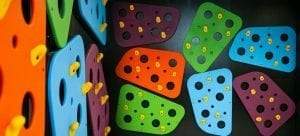Climbing adds enrichment to schools, museums

Easy-install Climbing Wall Panels Add Vertical Enrichment to Schools and Museums
TacTiles transform spaces, no matter how big or small. Neither Vincent Yanker or Linnea DiBeraradino had any experience building a climbing structure of any sort, or setting routes on a climbing wall. Yet, both of them have in the last few months. Both have seen great rewards in their respective school and children’s museum after successfully facilitating an easy install of Eldorado Climbing’s TacTile PRISMA Panels with a slew of colorful, kid-friendly holds. “The kids wanted a climbing wall and raised the money themselves,” says Yanker, Facilities Manager of Arvada, Colorado’s Excel Academy Charter School. Through a fundraiser called Laps for Learning, students at the school earned enough money to help the Excel Academy purchase 18 PRISMA Panels, which Yanker and a co-worker installed themselves along one wall in their gymnasium in one day this past summer.

Though Yanker climbs a little, he says, he’d never set routes before. Nor had the two co-workers who helped him. “We had 100 holds,” he explains, saying they laid the grips on the ground and then envisioned how kids might climb on them. “We thought, ‘If I’m gonna go here to here,’ for example, ‘where would the next hold go?’ It was kind of fun,” he says. Yanker explains that they tried to place “platform-like” holds toward the bottom for feet, and holds that are easier to grab onto toward the top as hand holds. The team didn’t set specific routes because they wanted students to be able to utilize a range of holds, though they differentiate different route options for older and younger kids with colored tape. “We’re still adapting by watching the younger kids versus the older kids climb on the wall, and moving the holds for what’s best for all. They’re really easy to move with the hex tool that comes with the kit.” Yanker says that Excel Academy knew Eldorado Climbing offers route design with their walls, which would have been an easier way to go. “But,” he says, “we wanted to take it on ourselves and see what happened.” Now, climbing is part of the school’s P.E. curriculum. “The kids love it,” says Yanker. “And teachers love it, too, because it helps the kids learn self-control as they learn to slow down their breathing, plan their routes, and focus.” Kids also have to refrain from climbing too high, as they’re not allowed to place their feet above the black holds the school installed at the three-foot mark. (Different-colored holds serve more than one purpose in DIY climbing wall design!) “The teachers are noticing more self-control in the classroom after the kids climb,” says Yanker. And that’s a good thing in any elementary school. Schools aren’t the only types of facilities putting easy-install climbing walls to good use. Ohio’s Children’s Museum of Findlay recently converted an area previously used for a mock courtroom (which they relocated) into a 10-foot by 10-foot climbing wall using seven TacTile PRISMA Panels. “We wanted to do it for two reasons,” says the museum’s executive director, Linnea DiBeraradino. “One, physical fitness is a growing issue in the U.S., and we’re wanting kids to be more active—a climbing wall seemed like a good way to incorporate that into the museum. And two, we’re always trying to make sure we’re reaching all ages of kids. We thought the wall would appeal to many.”

And she was right: From the day the new wall was installed, kids of all ages have been scrambling all over it. “From less fearful two-year-olds, to older kids who can touch the 10-foot ceiling—they’re all engaging in physical fitness in the museum,” she says. DiBeraradino and Yanker explain how neither of their climbing walls requires a harness or rope to access—they are bouldering walls, which only require padding at the base to protect the climbers. Both the kids’ rock wall at Excel Academy and the Children’s Museum of Findlay are 10-feet max, the perfect height for kids to climb safely up and down or traverse from one side of the wall to the other. Plus, they both have mats to buffer falls. Excel Academy’s mat clips to the wall when not in use, while the museum’s stays put. “To some extent,” says DiBeraradino, “we want to encourage risky play that helps them explore.”




Leave a comment